Is it difficult to control sodium intake? 5 tips to help you avoid excessive sodium intake

|
Controlling sodium intake requires limiting salt intake, and the recommended daily salt intake should not exceed 5g. With the development of the food industry, the sources of sodium have become diversified, not just salt and soy sauce. ① Eat more fresh food and less processed food, and try to use the food’s own flavor in cooking, such as steaming, boiling, etc. ② Use natural ingredients for seasoning, such as ginger, onion, garlic, lemon juice, onion, chili, pepper, and Sichuan pepper. ③ Use tools to quantify salt usage, such as preparing salt-limiting spoons, quantitative salt shakers, etc., to control salt intake. ④ Identify hidden salt, and use less or no high-sodium condiments such as chicken essence, MSG, bean paste, and soybean paste. ⑤ Learn to read labels and refuse high-salt foods such as luncheon meat, sausages, bacon, canned food, preserved fruits, etc. |
<<: "Iris photography" is a big hit! Taking photos of your eyeballs, doctors warn: It's dangerous!
Recommend
What are the breast examination items?
Nowadays, many women pay special attention to bre...
Doctors teach you a few tips to relieve gastrointestinal bloating
Have you ever felt this way? Ate a little food My...
Is it okay to have white hair on your pubic area?
Regardless of whether it is a man or a woman, the...
Menstrual cycle 35 to 40 days
Generally, every woman has her period, which is a...
"Aimeiyi" prevention and treatment knowledge series - Syphilis
Syphilis, a chronic infectious disease caused by ...
Breast discharge in late pregnancy
Women need to take care of their physical health ...
Acupuncture point massage method for breast enhancement
For many women with flat chests, breast enhanceme...
Is margarine made from lard? How to identify margarine
Margarine is a substitute for natural butter. It ...
53 years old, had ovaries and uterus removed
When a woman's uterus matures, she will have ...
What is the cause of high urine protein in late pregnancy?
During pregnancy, every pregnant mother hopes tha...
Pregnant one month after induced abortion
Both artificial abortion and induced labor are tw...
The uglier these parts of your body are, the healthier you are!
One minute with the doctor, the postures are cons...
How to remove pregnancy spots
What is the best way to remove freckles? How to g...
Is the Minting early pregnancy test paper sensitive?
Want to know how sensitive the Yuting pregnancy t...
Is emergency tracheal intubation outside the operating room the responsibility of the anesthesiology department?
At present, there are still many hospitals that r...









